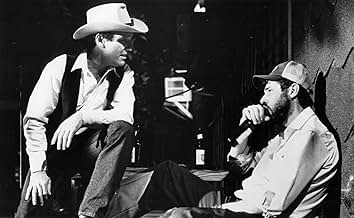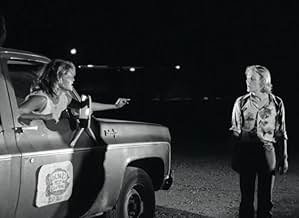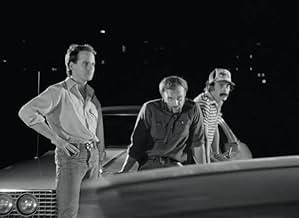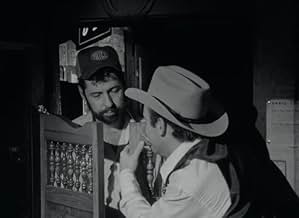Aggiungi una trama nella tua linguaCowboy, and assorted blue collar buddies, inneffectually try to save a true Texas Honky Tonk from closing for good.Cowboy, and assorted blue collar buddies, inneffectually try to save a true Texas Honky Tonk from closing for good.Cowboy, and assorted blue collar buddies, inneffectually try to save a true Texas Honky Tonk from closing for good.
- Regia
- Sceneggiatura
- Star
- Premi
- 1 candidatura in totale
Lou Perryman
- Claude Grimes
- (as Louis Perryman)
Earnest Huerta Jr.
- Hector
- (as Earnest 'El Diamond' Huerta Jr.)
Recensioni in evidenza
This hard-to-find gem is more than a slice of Texas, it's a slice of America. It's the final night of the local loser hangout, shot as if you just walked in the place and hung out for an hour and a half. I really wonder how much of the film's dialogue was actually scripted and how much was adlibbed. There are some truly funny one-liners early on (Mostly by "Claude"). The non-stop profanity does get a little unrealistic and the ending was sort of unsatisfactory, however, what we have is a film containing most of the elements of a truly classic independent film. Sort of a po' man's "Last Picture Show". Seek it out.
My review was written in October 1983 after a screening at the New York Film Festival.
"Last Night at the Alamo" is a low-budget Texas film that boasts a lot of actors' energy but lacks the cinematic style to let it escape from he specialized category. With nearly all the action set in a small Houston bar, pic perilously recalls a Southern-fried "Iceman Cometh".
Filmmakers Eagle Pennell and Kim Henkel (latter a co-scripter of Tobe Hooper's "The Texas Chainsaw Massacre") are fans of "The Wild Bunch", but what they have taken from that film is not its style or themes but rather the folksy, vibrant dialog of Walon Green and Sam Peckinpah. This gives "Alamo" considerable verbal texture, as characters carry on in local argot or cha about clothing bought at the "Monkey Ward's" department store.
Opening reel is so densely packed with four-letter expletives that the initially disarming device becomes tiresome. So, too, do the players, declaiming endlessly in the pipe dreams and complaints manner of barflies. Ichabod (Steve Matilla) is a scrawny young man, shooting pool, picking fights and trying to scoot his gal Mary (Tina-Bess Hubbard) off to the nearest hot-sheets motel. Claude (Louis Perryman) is a loud and foul-mouthed guy with wife trouble, constantly (and tediously) on the phone at the Alamo bar.
A late arrival is made by Cowboy Regan (Sonny Carl Davis), a smug, egocentric guy who believes he can "save" the Alamo, which has been sold by its owner and is due for immediate demolition to make way for high-rise buildings, appealing by phone to his old college roommate and now a state representative. Though he beats up an old high school rival Steve (J. Michael Hammond) who dares to doubt this claim, the effort to save the bar is, of course, just another pipe dream.
Director Pennell errs in shooting his film in a style reminiscent of live tv drama in the 1950s: low-key (for high contrast) lighting in black and white and claustrophobic framing (such as a foreground head, typically Claude's on the phone, dominating mid-ground action). Cumulative effect is oppressive. His actors are on too long a leash, with Louis Perryman's initially entertaining explosive swearing routine ending up sounding like a Steve Landesburg stand-up parody of a "good ole boy" dialect.
Lead player Davis, a balding young actor resembling Robert Duvall and Robert Stack, carries much of the picture by underplaying compared to the rest of the cast. Steven Matilla as "don't call me Ichabod" is quite funny in small doses and scripter Henkel has written himself in a cute John Sayles-esque deadpan role as Lionel, so laconic a critter that everyone else has to tell his personal anecdotes for him. The women's roles are seriously underwritten.
Tech credits are acceptable, though he direct sound recorded dialect gets a bit thick during some of the shouting matches.
"Last Night at the Alamo" is a low-budget Texas film that boasts a lot of actors' energy but lacks the cinematic style to let it escape from he specialized category. With nearly all the action set in a small Houston bar, pic perilously recalls a Southern-fried "Iceman Cometh".
Filmmakers Eagle Pennell and Kim Henkel (latter a co-scripter of Tobe Hooper's "The Texas Chainsaw Massacre") are fans of "The Wild Bunch", but what they have taken from that film is not its style or themes but rather the folksy, vibrant dialog of Walon Green and Sam Peckinpah. This gives "Alamo" considerable verbal texture, as characters carry on in local argot or cha about clothing bought at the "Monkey Ward's" department store.
Opening reel is so densely packed with four-letter expletives that the initially disarming device becomes tiresome. So, too, do the players, declaiming endlessly in the pipe dreams and complaints manner of barflies. Ichabod (Steve Matilla) is a scrawny young man, shooting pool, picking fights and trying to scoot his gal Mary (Tina-Bess Hubbard) off to the nearest hot-sheets motel. Claude (Louis Perryman) is a loud and foul-mouthed guy with wife trouble, constantly (and tediously) on the phone at the Alamo bar.
A late arrival is made by Cowboy Regan (Sonny Carl Davis), a smug, egocentric guy who believes he can "save" the Alamo, which has been sold by its owner and is due for immediate demolition to make way for high-rise buildings, appealing by phone to his old college roommate and now a state representative. Though he beats up an old high school rival Steve (J. Michael Hammond) who dares to doubt this claim, the effort to save the bar is, of course, just another pipe dream.
Director Pennell errs in shooting his film in a style reminiscent of live tv drama in the 1950s: low-key (for high contrast) lighting in black and white and claustrophobic framing (such as a foreground head, typically Claude's on the phone, dominating mid-ground action). Cumulative effect is oppressive. His actors are on too long a leash, with Louis Perryman's initially entertaining explosive swearing routine ending up sounding like a Steve Landesburg stand-up parody of a "good ole boy" dialect.
Lead player Davis, a balding young actor resembling Robert Duvall and Robert Stack, carries much of the picture by underplaying compared to the rest of the cast. Steven Matilla as "don't call me Ichabod" is quite funny in small doses and scripter Henkel has written himself in a cute John Sayles-esque deadpan role as Lionel, so laconic a critter that everyone else has to tell his personal anecdotes for him. The women's roles are seriously underwritten.
Tech credits are acceptable, though he direct sound recorded dialect gets a bit thick during some of the shouting matches.
I was lucky enough to catch this on the Independent Film Channel, thinking it was a different film entirely. Within a few minutes, I was engrossed.
It seemed from the very beginning that I was watching real people, not actors; that someone was just filming what happened to be going on. The fact that several of the actors have no other credits besides Last Night At the Alamo bears out this theory.
These are real people with real jobs, real lives and real problems. You can go to any dank bar in America and find exactly the same people you're watching, here, and they'll act exactly the same way. They come in, tell lame stories, posture for each other, and get drunker and stupider as the night goes on.
The byplay between Cowboy and Claude was interesting; it felt like a seduction, at times. It would have added a new dimension to the film if Cowboy had actually been trying to put the moves on his friend, but the filmmakers copped out on that one.
As more and more characters showed up at the bar, I started to think that Cowboy didn't even exist, and I'd been suckered into a drunken version of 'Waiting for Godot'. When he did show up, I immediately began to wonder exactly why he was so popular with the patrons - and believe me, there's a guy like that in EVERY bar.
It's difficult to describe the rest; the concept was so simple, it boils down into very few words. It looks like this film hasn't been released to the home market, yet, so I'll have to keep my eyes open and tape it, next time it comes around. I suggest you do the same.
It seemed from the very beginning that I was watching real people, not actors; that someone was just filming what happened to be going on. The fact that several of the actors have no other credits besides Last Night At the Alamo bears out this theory.
These are real people with real jobs, real lives and real problems. You can go to any dank bar in America and find exactly the same people you're watching, here, and they'll act exactly the same way. They come in, tell lame stories, posture for each other, and get drunker and stupider as the night goes on.
The byplay between Cowboy and Claude was interesting; it felt like a seduction, at times. It would have added a new dimension to the film if Cowboy had actually been trying to put the moves on his friend, but the filmmakers copped out on that one.
As more and more characters showed up at the bar, I started to think that Cowboy didn't even exist, and I'd been suckered into a drunken version of 'Waiting for Godot'. When he did show up, I immediately began to wonder exactly why he was so popular with the patrons - and believe me, there's a guy like that in EVERY bar.
It's difficult to describe the rest; the concept was so simple, it boils down into very few words. It looks like this film hasn't been released to the home market, yet, so I'll have to keep my eyes open and tape it, next time it comes around. I suggest you do the same.
10jimidom
I think the same elements that have made "King Of The Hill" a hit comedy are present in this cult film masterpiece. Just as there are everyday-life characters that closely resemble Hank Hill, Dale, and Boomhower, there are real people much like Cowboy, Claude, Ichabod, and the rest of the gang who like to hang out at the Alamo. It is this realism of the characters that makes "Last Night At the Alamo" so good.
This film brilliantly plays more like a documentary than a feature film, and it is shot in black & white. The use of live sound as opposed to overdubs also lends to this documentary-type feel. "Last Night At the Alamo" is very unique in that regard.
The acting was superb, especially Lou Perry as Claude. Sonny Carl Davis, most well-remembered as the jerk businessman who demands a refund from Brad Hamilton in "Fast Times At Ridgemont High", was excellent as the charismatic Cowboy Regan. Furthermore, Steve Mattila turned in a memorable performance as the annoying Ichabod.
Eagle Pennell may have captured the most realistic portrayal of blue-collar Texas ever. Because of this in my opinion, this film ranks right up there with greatest Texas films of time like "Giant", "the Alamo", "Urban Cowboy", and "the Last Picture Show".
This film brilliantly plays more like a documentary than a feature film, and it is shot in black & white. The use of live sound as opposed to overdubs also lends to this documentary-type feel. "Last Night At the Alamo" is very unique in that regard.
The acting was superb, especially Lou Perry as Claude. Sonny Carl Davis, most well-remembered as the jerk businessman who demands a refund from Brad Hamilton in "Fast Times At Ridgemont High", was excellent as the charismatic Cowboy Regan. Furthermore, Steve Mattila turned in a memorable performance as the annoying Ichabod.
Eagle Pennell may have captured the most realistic portrayal of blue-collar Texas ever. Because of this in my opinion, this film ranks right up there with greatest Texas films of time like "Giant", "the Alamo", "Urban Cowboy", and "the Last Picture Show".
Steve Mattilla is amazing in this film. His portrayal of Ichabod is the epitome of physical acting. I loved this film and I think that anyone who longs for their wine and roses days (or their beer and beer nuts days,) will feel a twinge of pain at the demise of the Alamo.
Lo sapevi?
- QuizThe bar where the film was shot was still in business, so daily shooting had to finish by 4:00 p.m. when it opened for the evening to the public.
- BlooperIn the opening shot of Ichabod and Mary in the pickup truck, a crew person can be seen standing in the back of the truck in a reflection of several passing storefront windows.
- Colonne sonoreApocalypso
Composed by John Sargent
Performed by John Sargent (vocals and guitar), Chuck Pinnell (guitar), Alvin Helge (bass), and Fred Gumace (drums)
I più visti
Accedi per valutare e creare un elenco di titoli salvati per ottenere consigli personalizzati
Dettagli
- Data di uscita
- Paese di origine
- Sito ufficiale
- Lingua
- Luoghi delle riprese
- The Old Barn, 4317 Harrisburg Blvd., Houston, Texas, Stati Uniti(The Alamo Bar; torn down in the early 2000s)
- Aziende produttrici
- Vedi altri crediti dell’azienda su IMDbPro
Botteghino
- Budget
- 25.000 USD (previsto)
- Tempo di esecuzione1 ora 21 minuti
- Colore
- Mix di suoni
- Proporzioni
- 1.85 : 1
Contribuisci a questa pagina
Suggerisci una modifica o aggiungi i contenuti mancanti

Divario superiore
By what name was Last Night at the Alamo (1983) officially released in Canada in English?
Rispondi






















